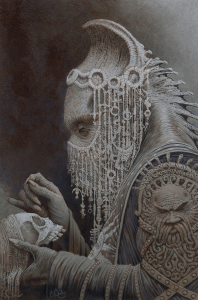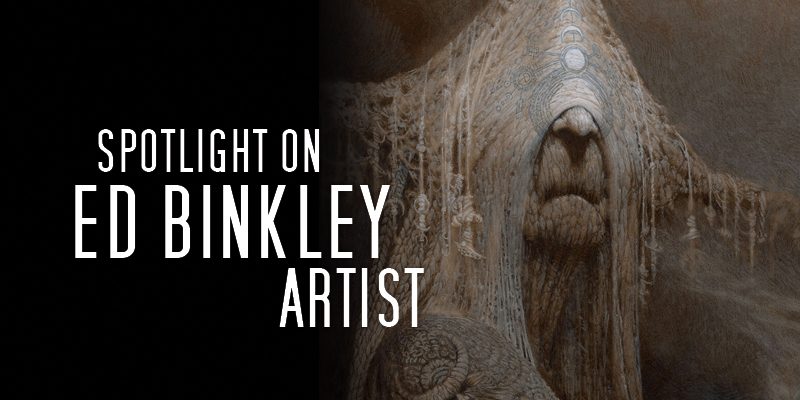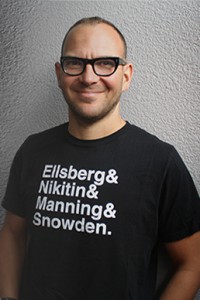Spotlight on Ed Binkley
 Ed Binkley has created fantasy artwork for three decades. He received the First Place Grand Prize in Infected by Art Volume 10 as well as the Body of Work award. His work is published in numerous issues of Spectrum: The Best in Contemporary Fantastic Art where he won Gold and Silver awards, and he was a finalist in the Beautiful Bizarre Art Award competition in 2019, 2020, 2021, and 2022. He was featured in solo exhibits at the Copro Gallery in California and the Beinart Gallery in Melbourne, and his work is part of the permanent collection of the Naia Museum in Roche-en-Forte, France. He lives and works in Madison WI.
Ed Binkley has created fantasy artwork for three decades. He received the First Place Grand Prize in Infected by Art Volume 10 as well as the Body of Work award. His work is published in numerous issues of Spectrum: The Best in Contemporary Fantastic Art where he won Gold and Silver awards, and he was a finalist in the Beautiful Bizarre Art Award competition in 2019, 2020, 2021, and 2022. He was featured in solo exhibits at the Copro Gallery in California and the Beinart Gallery in Melbourne, and his work is part of the permanent collection of the Naia Museum in Roche-en-Forte, France. He lives and works in Madison WI.

Building strong (and sometimes bizarre) character portraits is central to your work. Talk a bit about the process of building up a character.
I’ve always been fascinated with portraiture, especially 19th-century photographs and daguerreotypes. When I start working on a new character I frequently have a concept in mind, or sometimes I start scribbling and ‘‘see what I see,’’ an approach I borrowed from my concept-art friends. In any case, the character usually begins to tell me their own story, and story drives everything I create. I always have a character’s story in mind as I work, even if it’s only a sentence or two.
Your self-published book, Incognito: Strange Neighbors and Distant Relations, was on the 2022 Locus Recommended Reading List. Talk a bit about that project and any planned future publications.
Thank you so much to Locus for including my book on the list! The book is a collection of 35 of my ‘‘Goblins-incognito,’’ creatures, whom I have imagined being subsumed into our own civilization, where they are trying to make their way – their struggles, anxieties, adaptations, and successes. I’ve envisioned a series of three books in the coming years, each designed around a particular genre of my artwork.

What does your workflow look like from concept to realization and do you use digital media? Any unusual techniques?
I usually begin with very rough sketches, sometimes literally scribbles, aimed at a general character type I want to do. Frequently the sketching process suggests features, textures, and even part of the concept or narrative, so I try to stay open to happy accidents. Although I taught digital illustration for many years, the only digital element in my current work is the grungy, textured background (which also can suggest textures, especially for creatures who have less than ideal complexions), and I draw with mostly colored pencil on top of that grungy texture. I discovered accidentally years ago that it takes colored pencil beautifully and allows me to draw light-over-dark, which is nearly impossible with straight colored-pencil on white paper.

Talk a bit about one of your most interesting illustration projects. What’s it like to illustrate an author’s work? How do you engage with the work and make it your own while still honoring the source material?
Two projects come to mind. I was invited to participate in the Star Wars: Visions book project with Lucasfilm, in which 100 artists were asked to re-envision any aspect of Star Wars we wanted to. This was so much fun, because Lucasfilm keeps very tight control over the look of their world and characters. I chose the Tusken Raiders, and decided to make them look more terrifying since they were basically terrorists who sat in the hills and took pot-shots at passersby. Lucasfilm also chose my illustration for the project’s introduction poster at San Diego Comic-Con.
The most interesting technical challenge I faced was probably the ‘‘Village Scene’’ jigsaw puzzle I was commissioned to do for Artifacts Puzzles. Complex puzzles cannot allow any open negative spaces since the puzzle-solver needs something on each small piece, so I had to keep adding and adding details until literally every square inch included something. It was fun, but quite challenging.

You have taught illustration and concepting. What are the most important lessons you try to convey to your students?
A few foundation principles: good design/composition, which helps hold a complex image together and clarifies things. I also stressed the importance of narrative, even a brief story students might make up as they go, since story can answer so many questions that arise while you work. And finally, the importance of constant hard work – as an artist it’s important to draw your way out of problems rather than just trying to think your way out. I believe I have sometimes succeeded in projects by outworking other artists who were more talented. It’s the one factor over which I’ve always believed I had complete control.
While you are here, please take a moment to support Locus with a one-time or recurring donation. We rely on reader donations to keep the magazine and site going, and would like to keep the site paywall free, but WE NEED YOUR FINANCIAL SUPPORT to continue quality coverage of the science fiction and fantasy field.
©Locus Magazine. Copyrighted material may not be republished without permission of LSFF.








